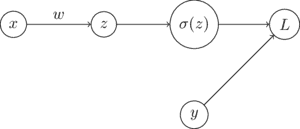Introduction
Logistic regression is a parametric classification method that is used to estimate binary class output given real-valued input vectors. In this post, cross entropy loss is used as the loss function and gradient descent (or batched gradient descent) is used to learn parameters.
The computation graph below shows how logistic regression works. The dot product of each input, a vector of size , and weight vector transposed is taken, resulting in . is put through the sigmoid function, and the loss is calculated using the mean squared error on label and .
The bias term is ignored for the purposes of this post, but can easily be appended to weight vector after appending a to an input vector .
Learning
Given a data set of size with dimensions, parameters must be learned that minimize our loss function . The weight vector is learned using gradient descent. The derivation for term in the weight update is displayed in the derivations section of this post.
Code
Code for a logistic regression classifier is shown in the block below
from typing import List
from tqdm import trange
import torch
def ErrorRate(y: torch.Tensor, yhat: torch.Tensor) -> float:
""" Calculate error rate (1 - accuracy)
Args:
y: true labels
yhat: predicted labels
Returns:
error rate
"""
return torch.sum((y != yhat).float()) / y.shape[0]
class LogisticRegressionClassifier:
def __init__(self) -> None:
""" Instantiate logistic regression classifier
"""
self.w = None
self.calcError = ErrorRate
def fit(self, x, y, alpha=1e-4, epochs=1000, batch=32) -> None:
""" Fit logistic regression classifier to dataset
Args:
x: input data
y: input labels
alpha: alpha parameter for weight update
epochs: number of epochs to train
batch: size of batches for training
"""
self.w = torch.rand((1, x.shape[1]))
epochs = trange(epochs, desc='Error')
for epoch in epochs:
start, end = 0, batch
for b in range((x.shape[0]//batch)+1):
hx = self.probs(x[start:end])
dw = self.calcGradient(x[start:end], y[start:end], hx)
self.w = self.w - (alpha * dw)
start += batch
end += batch
hx = self.predict(x)
error = self.calcError(y, hx)
epochs.set_description('Err: %.4f' % error)
def probs(self, x: torch.Tensor) -> torch.Tensor:
""" Determine probability of label being 1
Args:
x: input data
Returns:
probability for each member of input
"""
hx = 1 / (1 + torch.exp(-torch.einsum('ij,kj->i', x, self.w)))[:, None]
return hx
def predict(self, x: torch.Tensor) -> torch.Tensor:
""" Predict labels
Args:
x: input data
Returns:
labels for each member of input
"""
hx = self.probs(x)
hx = (hx >= 0.5).float()
return hx
def calcGradient(self, x: torch.Tensor, y: torch.Tensor, hx: torch.Tensor) -> torch.Tensor:
""" Calculate weight gradient
Args:
x: input data
y: input labels
hx: predicted probabilities
Returns:
tensor of gradient values the same size as weights
"""
return torch.sum(x * (hx - y), dim=0) / x.shape[0]
Derivations
Derivative of loss function with respect to sigmoid output :
Derivative of sigmoid function with respect to sigmoid input :
Derivative of linear combination with respect to weight :
Derivative of loss function with respect to weight :
Resources
- Jurafsky, Daniel, and James H. Martin. Speech and Language Processing: An Introduction to Natural Language Processing, Computational Linguistics, and Speech Recognition. Pearson, 2020.
- Russell, Stuart J., et al. Artificial Intelligence: A Modern Approach. 3rd ed, Prentice Hall, 2010.
